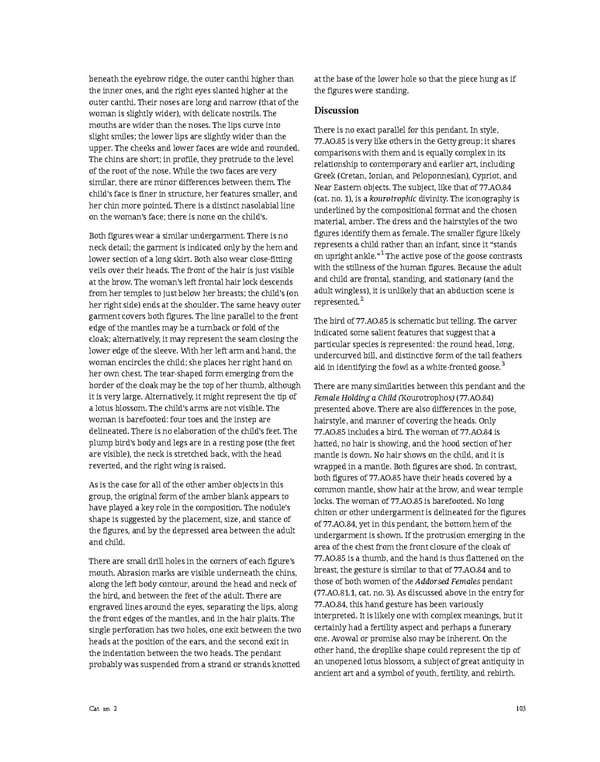beneath the eyebrow ridge, the outer canthi higher than at the base of the lower hole so that the piece hung as if the inner ones, and the right eyes slanted higher at the the figures were standing. outer canthi. Their noses are long and narrow (that of the Discussion woman is slightly wider), with delicate nostrils. The mouths are wider than the noses. The lips curve into There is no exact parallel for this pendant. In style, slight smiles; the lower lips are slightly wider than the 77.AO.85 is very like others in the Getty group; it shares upper. The cheeks and lower faces are wide and rounded. comparisons with them and is equally complex in its The chins are short; in profile, they protrude to the level relationship to contemporary and earlier art, including of the root of the nose. While the two faces are very Greek (Cretan, Ionian, and Peloponnesian), Cypriot, and similar, there are minor differences between them. The Near Eastern objects. The subject, like that of 77.AO.84 child’s face is finer in structure, her features smaller, and (cat. no. 1), is a kourotrophic divinity. The iconography is her chin more pointed. There is a distinct nasolabial line underlined by the compositional format and the chosen on the woman’s face; there is none on the child’s. material, amber. The dress and the hairstyles of the two Both figures wear a similar undergarment. There is no figures identify them as female. The smaller figure likely neck detail; the garment is indicated only by the hem and represents a child rather than an infant, since it “stands lower section of a long skirt. Both also wear close-fitting on upright ankle.”1 The active pose of the goose contrasts veils over their heads. The front of the hair is just visible with the stillness of the human figures. Because the adult at the brow. The woman’s left frontal hair lock descends and child are frontal, standing, and stationary (and the from her temples to just below her breasts; the child’s (on adult wingless), it is unlikely that an abduction scene is her right side) ends at the shoulder. The same heavy outer represented.2 garment covers both figures. The line parallel to the front The bird of 77.AO.85 is schematic but telling. The carver edge of the mantles may be a turnback or fold of the indicated some salient features that suggest that a cloak; alternatively, it may represent the seam closing the particular species is represented: the round head, long, lower edge of the sleeve. With her left arm and hand, the undercurved bill, and distinctive form of the tail feathers woman encircles the child; she places her right hand on aid in identifying the fowl as a white-fronted goose.3 her own chest. The tear-shaped form emerging from the border of the cloak may be the top of her thumb, although There are many similarities between this pendant and the it is very large. Alternatively, it might represent the tip of Female Holding a Child (Kourotrophos) (77.AO.84) a lotus blossom. The child’s arms are not visible. The presented above. There are also differences in the pose, woman is barefooted: four toes and the instep are hairstyle, and manner of covering the heads. Only delineated. There is no elaboration of the child’s feet. The 77.AO.85 includes a bird. The woman of 77.AO.84 is plump bird’s body and legs are in a resting pose (the feet hatted, no hair is showing, and the hood section of her are visible), the neck is stretched back, with the head mantle is down. No hair shows on the child, and it is reverted, and the right wing is raised. wrapped in a mantle. Both figures are shod. In contrast, As is the case for all of the other amber objects in this both figures of 77.AO.85 have their heads covered by a group, the original form of the amber blank appears to common mantle, show hair at the brow, and wear temple have played a key role in the composition. The nodule’s locks. The woman of 77.AO.85 is barefooted. No long shape is suggested by the placement, size, and stance of chiton or other undergarment is delineated for the figures the figures, and by the depressed area between the adult of 77.AO.84, yet in this pendant, the bottom hem of the and child. undergarment is shown. If the protrusion emerging in the area of the chest from the front closure of the cloak of There are small drill holes in the corners of each figure’s 77.AO.85 is a thumb, and the hand is thus flattened on the mouth. Abrasion marks are visible underneath the chins, breast, the gesture is similar to that of 77.AO.84 and to along the left body contour, around the head and neck of those of both women of the Addorsed Females pendant the bird, and between the feet of the adult. There are (77.AO.81.1, cat. no. 3). As discussed above in the entry for engraved lines around the eyes, separating the lips, along 77.AO.84, this hand gesture has been variously the front edges of the mantles, and in the hair plaits. The interpreted. It is likely one with complex meanings, but it single perforation has two holes, one exit between the two certainly had a fertility aspect and perhaps a funerary heads at the position of the ears, and the second exit in one. Avowal or promise also may be inherent. On the the indentation between the two heads. The pendant other hand, the droplike shape could represent the tip of probably was suspended from a strand or strands knotted an unopened lotus blossom, a subject of great antiquity in ancient art and a symbol of youth, fertility, and rebirth. Cat. no. 2 103
 Ancient Carved Ambers in the J. Paul Getty Museum Page 112 Page 114
Ancient Carved Ambers in the J. Paul Getty Museum Page 112 Page 114